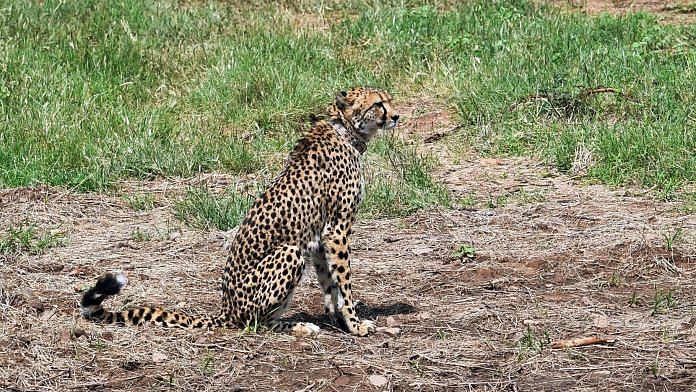New Delhi: Daksha, a female cheetah from South Africa, was killed in a fight with two males in Madhya Pradesh’s Kuno National Park Tuesday, taking the death toll of trans-located cheetahs to three.
Officials and experts involved with the one-of-a-kind cheetah project have said the death was “natural and unavoidable”.
The 3-year-old female from South Africa’s Phinda reserve was killed after crossing paths with a coalition of two males, possibly during an attempt to mate.
“They must have tried mating, and she must have retaliated, which would have made them aggressive,” said J.S. Chauhan, chief wildlife warden of Madhya Pradesh.
According to a press note released by the Madhya Pradesh forest department, a decision was taken during a meeting on 30 April to allow the two males access to the female. All three were poised to be released to the wild before June.
On Tuesday morning, however, the males Agni and Vayu killed her during a “violent interaction”, the press note said.
The world’s first translocation project has divided conservationists across the world, with several criticising the costs and risks involved with “re-establishing” a free-ranging population of cheetahs.
Vincent Van Der Merwe of the Metapopulation Initiative, which facilitated the introduction of the South African cheetahs, said this was “frustrating”, but there wasn’t much that can be done to avoid a situation like this.
“It’s a natural mortality. If they were going to react like this, it would have happened whether they were in the enclosure or not,” he said, adding, “It is not unusual for male cheetahs to exhibit aggressive behaviour towards each other, as well as towards females. Cheetahs killing other cheetahs account for 8% of cheetah mortality in the Southern African metapopulation.”
The meeting on 30 April was attended by cheetah veterinarian Adrian Tordiffe from University of Pretoria, Van Der Merwe, Lead Scientist at Wildlife Institute of India Qamar Qureshi, and Inspector General of Forests, National Tiger Conservation Authority, Amit Mallick.
During the meeting it was also decided that five cheetahs – three females and two males – would be released into the wild before the onset of the monsoon season. Daksha, Agni and Vayu were all due to be released.
“The two males will be released first,” Chauhan had said, with two other females following.
A Namibian female had successfully mated with a male in an enclosure and gave birth to four cubs in March.
“The South African cheetahs are totally wild born, and are more aggressive. The Namibian ones are more used to being in enclosures since many of them have spent some time in captivity,” Van Der Merwe said.
Daksha’s death marks the third, after Sasha (5-year-old female from Namibia) died of a kidney infection in March and Uday (male of unknown age from South Africa) died of suspected heart failure last month.
The project started last September with Prime Minister Narendra Modi releasing eight Namibian cheetahs into Kuno on his 72nd birthday. Twelve animals from South Africa were introduced in February.
On Monday, the Ministry of Environment said investigation into the underlying causes of Uday’s death have not yet concluded.
After the four cheetahs are released, another 10 will follow after the monsoon ends in September, the ministry said.
Also read: Cheetah is India’s new conservation icon after tiger. It can save grasslands



